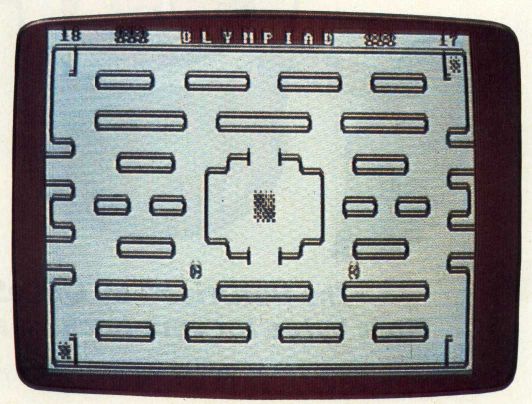Olympiad
Kevin Woram and Mike Buhidar, Jr.
In this mythical struggle between a magician and a king, you decide the fate of the realm with your joystick. Written for the 64, we've included versions for the VIC and Atari.
Long ago Admar, a magician of great power, served the king of Denbar as an advisor in matters of war. Through the years Admar's power grew so much that the king began to fear him. Foolishly, the king decided that because of his power, Admar could no longer be trusted, and he plotted to kill the magician.
Admar, however, was still loyal to the king, and when he learned of the king's plot he decided to flee the kingdom with a legion of his own loyal warriors.
The king followed with his army and attacked Admar's stronghold, resulting in heavy casualties on both sides. Both the king and Admar now realized that warfare would be very costly in lives.
An Enchanted Arena
So it was agreed that an enchanted arena should be built where the king's Black Knights would do mock battle with Admar's Red Knights.
You and a friend control the actions of the knights as they fight for their masters. Movement in all eight directions is controlled by the joystick. The red knight is controlled by the joystick in control port 1, the black knight by the joystick in port 2.
The knights have also been given 20 magical arrows which stun on contact. The arrows are launched by pressing the fire button. When a fighter has used all of his arrows, his only defense is to run.

Teleportation Grids
To add an element of randomness to the battle, three enchanted teleportation grids have been added to the arena. When any warrior steps onto one of these grids, he is instantly teleported to a random position in the arena.
Notes For VIC And Atari Versions
Chris Poer, Editorial Programmer
The object of "Olympiad" is to defeat your opponent's three knights with three or your own in one-on-one combat. In the VIC version, player 1 controls his knight with the joystick while player 2 uses the keyboard (I, J, K, and M keys for up, left, right, and down movements, respectively). In the Atari version, the knights are controlled with joysticks 0 and 1.
When the game begins, position yourself directly in front of the enemy. Press the joystick button (or space bar in the VIC version) to fire an arrow Arrows trawl only a certain distance In addition, each knight has only 20 arrows in his quiver, so be careful not to waste any. If both warriors exhaust their supply of arrows, the round will start anew, with each player receiving a fresh supply of 20 arrows
The VIC version requires 8K or more of expansion RAM. Before loading the game into the VIC (right after the computer is turned on), carefully enter the following lines:
POKE43, 1 : POKE44, 32 : POKE8192, 0: NEW POKE36869, 240: POKE36866, 150: POKE648, 30PRINT "{CLR}"
Typing Olympiad
All three versions of "Olympiad" make extensive use of keyboard graphics in drawing the arena display. To avoid confusion and possible typing errors, please refer to the article "How To Type COMPUTED Programs" before you attempt to enter these programs.
For the 64 version (lines 3010-3220) and VIC version (lines 3010-3210), pay close attention to the places where program lines are divided on the page. If any spaces are to be left after the characters on one line of the page, the correct number of spaces will be indicated in braces at the beginning of the next line. Unless you are specifically instructed to type spaces, do not do so. For example, in the statement below there should be no spaces between the SHIFTed characters on the first line and the cursor lefts at the start of the second, and only four spaces (as specified in the braces) should be typed between the SHIFTed characters at the end of the second line and those at the beginning of the third.
400 PRINT"-[<R>]JCCCCCK{2 SPACES}JCCCCCK
{6 LEFT}{2 DOWN}JCCCCCCCCCCCCK
{4 SPACES}JCCCCCK"; :rem 128
In the Atari version, many special graphics characters are used in lines 3010—3240. Be sure you understand how to type these before you start. In particular, the vertical bar character (I) used frequently in these lines is obtained by pressing the SHIFT and = keys simultaneously.